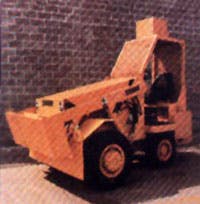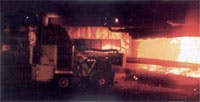Silicon — a critical metal used in the alloying of steel, aluminum, and other metals, in making organic silicone products, in electronic semiconductors, and many other areas — is produced by smelting in open-top electric furnaces using the submerged-arc process. These furnaces, typically 20 to 40 ft in diameter and depth, consume huge amounts of low-voltage, high-current electricity. The furnaces are charged through their open tops with a mixture of quartz (silicon dioxide) gravel, coal, steel turnings, and hardwood chips. The process chemically reduces the silicon dioxide and molten silicon is tapped from the bottom of the furnace.
Material in the furnace must be graded to maintain a relatively flat surface. Also, any rigid top crust which forms could cause a localized hot spot, so crusts should be broken fairly quickly (within 15 min) for even furnace operation and uniform power consumption. (This is important because furnace owners are fined if power consumption goes over a set limit.) Charging, grading, and crust breaking must be performed 24 hr/day, 365 days a year because the furnaces operate nonstop.
For more than 20 years, Mixer Systems, Inc., Pewaukee, Wis., has built Stokar stoking/grading machines to handle this hot and demanding task. Fitted with a boom and a variety of accessory tools, the Stokar uses a 25-hp, 460-V, 1800-rpm, TEFC electric motor to drive a 3.3-in.3, variable-displacement hydrostatic pump that powers its propulsion. A separate 10-gpm gear pump delivers oil to a pressure-compensated flow divider, which supplies the non-feedback power steering, as well as other hydraulic functions. A remote, pivoting, spring-loaded reel holds the umbilical power cable taut between the electrical panel and the Stokar.
For propulsion, dual 2.5-in.3, bentaxis hydraulic motors turn 32-in. diameter solid-rubber tires through 22:1 planetary-reduction drive hubs. The motors are piped in parallel for a differential effect, which is essential for the tight turns required of this machine. The 6-ton Stokar has a top speed of 5½ mph, and spring-applied/pressure-released fail-safe brakes stop the wheel motors. In the event that a hydraulic hose bursts, these brakes instantly stop the machine, preventing it from rolling off the deck and into the furnace.
While the ambient temperature outside the furnace rarely exceeds 100° F, radiated heat from the large area of flames and red-hot coals is searing. On occasion, when ill-maintained Stokars have become disabled at the edge of the furnace lip, their tires began to smolder after only a few minutes. That is why Mixer Systems equips the drive hubs with push-button disconnects, the pressure- released brake system with an accumulator, and the hydraulic motors with a neutralizing valve. These arrangements allow an unpowered Stokar to be quickly rolled to a less hostile environment for service.
Although the Stokar is factory-equipped with forced-air oil coolers, users frequently remove them with no ill effects. This is due to:
• relatively low power — 25 hp gets the job done without overheating the hydraulic oil
• low duty cycle — typically 10 minutes of use, 15 minutes of rest, and
• good heat shielding — frame members are 1/2- to 2-in. thick steel plate. Exposed hydraulic lines are covered with reflective aluminum foil or fiberglass sleeves.
Seemingly, this would be an ideal application for water-based hydraulic fluid, but customers continue to demand oil. Remember, the ferro-silicon alloy plant is a dirty, low-tech environment, often located many miles from fluid power distributors. The operators want to stick with the tried and true.
Norm Anderson, manager of engineering, Mixer Systems, Inc., described the design of this equipment.



